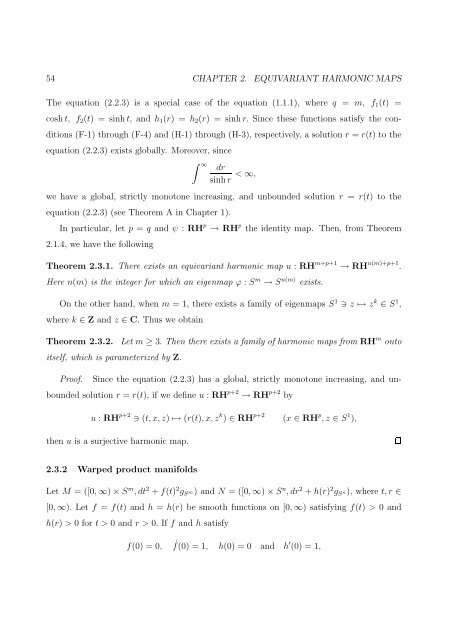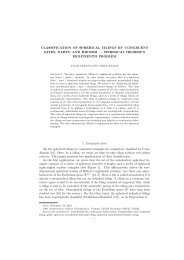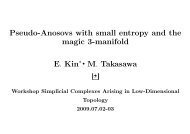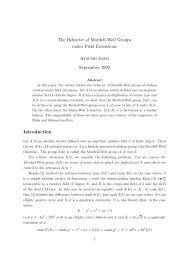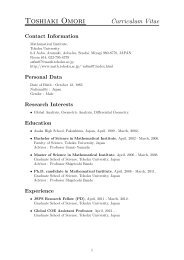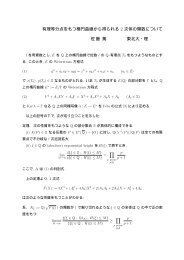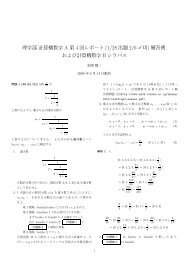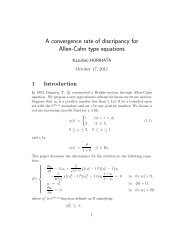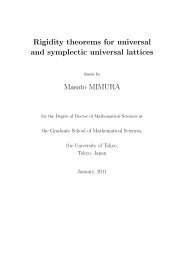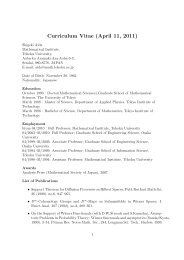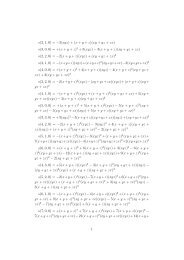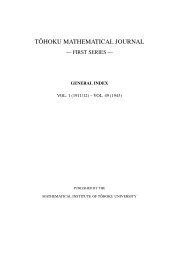Constructions of harmonic maps between Hadamard manifolds
Constructions of harmonic maps between Hadamard manifolds
Constructions of harmonic maps between Hadamard manifolds
You also want an ePaper? Increase the reach of your titles
YUMPU automatically turns print PDFs into web optimized ePapers that Google loves.
54 CHAPTER 2. EQUIVARIANT HARMONIC MAPS<br />
The equation (2.2.3) is a special case <strong>of</strong> the equation (1.1.1), where q = m, f 1 (t) =<br />
cosh t, f 2 (t) = sinh t, and h 1 (r) =h 2 (r) = sinh r. Since these functions satisfy the conditions<br />
(F-1) through (F-4) and (H-1) through (H-3), respectively, a solution r = r(t) to the<br />
equation (2.2.3) exists globally. Moreover, since<br />
∫ ∞<br />
dr<br />
sinh r < ∞,<br />
we have a global, strictly monotone increasing, and unbounded solution r = r(t) to the<br />
equation (2.2.3) (see Theorem A in Chapter 1).<br />
In particular, let p = q and ψ : RH p → RH p the identity map. Then, from Theorem<br />
2.1.4, we have the following<br />
Theorem 2.3.1. There exists an equivariant <strong>harmonic</strong> map u : RH m+p+1 → RH n(m)+p+1 .<br />
Here n(m) is the integer for which an eigenmap ϕ : S m → S n(m) exists.<br />
On the other hand, when m =1, there exists a family <strong>of</strong> eigen<strong>maps</strong> S 1 ∋ z ↦→ z k ∈ S 1 ,<br />
where k ∈ Z and z ∈ C. Thus we obtain<br />
Theorem 2.3.2.<br />
itself, which is parameterized by Z.<br />
Pro<strong>of</strong>.<br />
Let m ≥ 3. Then there exists a family <strong>of</strong> <strong>harmonic</strong> <strong>maps</strong> from RH m onto<br />
Since the equation (2.2.3) has a global, strictly monotone increasing, and unbounded<br />
solution r = r(t), if we define u : RH p+2 → RH p+2 by<br />
u : RH p+2 ∋ (t, x, z) ↦→ (r(t),x,z k ) ∈ RH p+2 (x ∈ RH p ,z ∈ S 1 ),<br />
then u is a surjective <strong>harmonic</strong> map.<br />
2.3.2 Warped product <strong>manifolds</strong><br />
Let M = ([0, ∞) × S m ,dt 2 + f(t) 2 g S m) and N = ([0, ∞) × S n ,dr 2 + h(r) 2 g S n), where t, r ∈<br />
[0, ∞). Let f = f(t) and h = h(r) be smooth functions on [0, ∞) satisfying f(t) > 0 and<br />
h(r) > 0 for t>0 and r>0. If f and h satisfy<br />
f(0) = 0,<br />
˙ f(0) = 1, h(0) = 0 and h ′ (0) = 1,


